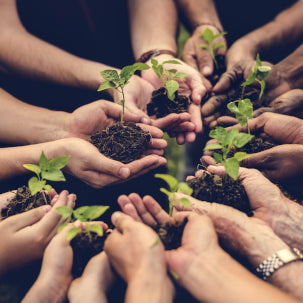
Soil is such a special resource on earth and is unfortunately being mistreated to the point of being unusable. Many of us just see it as dirt on the ground which makes us disconnected from the magic that is truly holds. Soil is a living organism that has so many benefits besides growing things! So what is soil and how does it work? Welcome to our guide.
In this guide, you’ll find everything you need to know to start understanding soil, including:
- What soil is and why it’s important.
- The 3 essential parts of soil that make it healthy.
- Tips, tools, and best practices to succeed with your own soil.
Read on so you can create your own thriving soil to grow healthier plants!
What is soil?
Soil is a mix of minerals (rocks), organic matter (decomposed plants & animals), and living creatures.
Why is soil important?
- It’s what grows and protects plants: We need plants to survive so making sure they can grow to their full potential has life changing effects. We have also found many important medicines from soil that have changed the way we live.
- It has the power to fix climate change: Soil is extremely efficient at absorbing and holding onto carbon dioxide (that gas in our atmosphere causing global warming). Farm land takes up 30% of all land mass on earth and keeping it healthy can absorb huge amounts of C02!
3 essential parts of healthy soil
Minerals
Minerals work their way into soil thanks to weathering (wind & rain breaking down rocks), chemical reactions (ever see fungi growing on rocks? Its slowly chipping them away!), and from decomposed plants/animals. There are 83 different types of minerals that plants need for life that we currently know about. They are an essential component of any healthy plant and unfortunately are the most common missing component.
Organic matter
Organic matter is the beautiful soft texture of soil that holds onto moisture and nutrients. It’s made of decomposed plant & animal matter that can take hundreds, if not thousands of years to create. Most soils are lacking in organic matter and can cause the soil to become hard and unable to absorb moisture. Adding it back is as simple as using compost.
Living creatures
Now this is where the magic really happens. There are billions of different living organisms in a teaspoon of healthy soil. Most are invisible to the naked eye, but all have specific functions. Larger organisms like worms and insects burrow through the soil allowing oxygen and moisture to penetrate the soil. Smaller organisms like bacteria and fungi attach themselves to roots where they protect plants from disease & pests. All of these organisms are also pooping in the soil! This is free and extremely nutritious fertilizer for plants and is happening 24/7.
How to build a healthy soil
You can build your own healthy soil at home in a snap! First you need to get a few simple ingredients:
Peat Moss or Coco Coir – We will call this our base, it gives soil structure and allows it to stay nice and fluffy.
Compost – You can use whichever type you like here, but the best ones are made locally.
Perlite or Vermiculite – Plants need oxygen to survive. Using a porous material that has lots of spaces for air is what we want and also helps with drainage.
A great starter mix is a 1:1:1 ratio. This just means that you’ll mix an equal part of each. For example if you wanted 3 gallons of soil, you would mix 1 gallon or coco coir, 1 gallon of compost, and 1 gallon of perlite together.
Soil tips/best practices
- When it comes to peat moss, it can become hydrophobic (won’t absorb water) when it dries out. We recommend coco coir, or a mix of the two.
- Avoid stinky compost, it can contain harmful microbes that can damage plants.
- Always make sure what you’re adding to soil it natural! Synthetics disturb the balance of living organisms.
- Less is always more! You can always add more but you cannot take it away.
Soil tools
- Soil test kit! This will tell you the pH and nutrient levels of your soil. You can purchase these online or at your local garden center.
- Spreadsheet of what type of soil your specific plant needs. If your plant likes more water, add more coco coir or compost to the mix. If the plants is water sensitive, add more perlite or vermiculite.
- pH test kit. We want to make sure the water we are using is the proper pH as this is how your plants feed. You can use lemon juice to lower the pH or baking soda to raise the pH.
Get started with soil today
You’re on your way to making some beautiful soil that your plants will absolutely love. So get out there and get your hands dirty!
